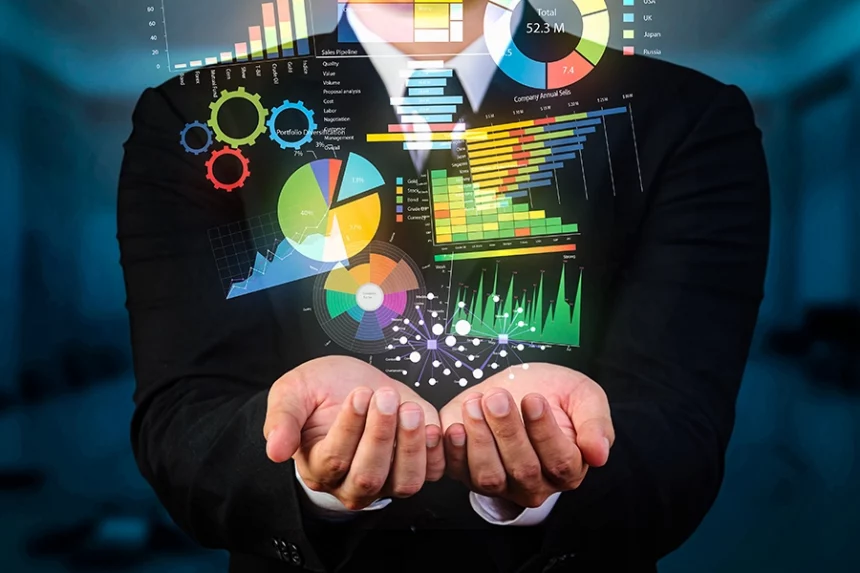With the rapid growth of data, learning how to properly visualize it is essential. Data visualization is the process of representing data in a graphical format to provide deeper insights, patterns, and trends. From financial and healthcare records to scientific and marketing research, data is generated from various sources and is used to make decisions in nearly every industry. Data visualization is an effective and efficient way to understand, interpret, and communicate data, making it a powerful tool for businesses and organizations. In this step-by-step guide, we will explore the basics of data visualization and how to unlock the power of data to gain valuable insights. Through this guide, you will understand the importance of data visualization, the different types of visualizations, and the tools and processes needed to create meaningful and effective data visualizations.
What is data visualization?
Data visualization is the process of using visual representations of data to explore patterns and relationships, generate insights, and share information. Data visualization is an effective and efficient way to understand and communicate data, and is used widely in business and organizations to make better decisions with data. Data visualization can be applied to various data types, including text, numbers, dates, times, and images. Although visuals can’t replace the actual data, they can provide a greater and more intuitive understanding, and allow people to process information more effectively and efficiently. Data visualization is the presentation of data, information, and analysis that uses graphs and charts to display patterns, trends, and relationships to make complex data easier to understand.
Benefits of data visualization
- Provides clarity and understanding – Data visualization gives readers a clear and understandable picture of what you’re trying to convey. It provides a snapshot of the data, highlights trends, and shows relationships between different variables.
- Builds trust – Data visualization builds trust and credibility with your audience. When you represent your data in a visual format, you show that you’ve done the research and have found patterns in the data that can be helpful to others.
- Helps you make better decisions – Data visualization is the process of using visual representations of data to explore patterns and relationships, generate insights, and share information. Visualizations can be anything from graphs, charts, and interactive dashboards to complex mathematical equations. Visualizing your data can help you make better decisions because you can see the bigger picture and discover any unexpected patterns or anomalies in your data.
- Reduces analysis time – Visualization can also help you reduce your analysis time and make the most out of your data. When you have the data visualized, you can easily identify problematic areas that could be the cause of bad numbers.
- Makes data more accessible – Visualization can make data more accessible to people who aren’t as familiar with numbers and statistics. By putting your data into visual form, you make it easier for everyone to understand and find value in it.
- Helps generate new ideas and insights – Data visualization can also help generate new ideas and insights from your data. When you visualize your data, you can gain new perspectives and see things in a different way. This can help you uncover patterns and connections that you might not have noticed otherwise.
- Helps build your credibility – Data visualization can also help build your credibility and make you seem more trustworthy. When you present your data in a visual format, you show that you’ve done the research and know what you’re talking about.
Types of data visualizations
- Graphs – Graphs are a type of visualization that uses data to plot points on a graph, usually with x- and y-axis coordinates. Graphs show relationships between data and can be used to explore patterns and data trends.
- Charts – Charts are another visualization that shows patterns and trends in data. Charts are more detailed compared to graphs, and can be found in tables, line graphs, and pie charts.
- Maps – Data visualizations like maps are used to show relationships between data points. Data points might be places, locations, or any other entities. Maps can be used to show trends and patterns in data with location-based data.
- Tables – Data visualization can also be in the form of tables. Data visualization in tables are great when you want to show comparisons between different variables.
- Dashboards – Dashboards are a popular form of data visualization, and are often used by businesses. A dashboard is a single page that displays all the data that a company needs to know.
- Stories – Another popular data visualization is the story visualization. A story visualization is a narrative representation of data that can be in the form of a graph, table, or chart. Story visualizations are great for communicating insights and helping others understand the data.
Best practices for data visualization
- Define your goal – Before you start creating visualizations, it’s important to define your goal. What are you trying to achieve with the visualization? What is the purpose of the visualization? What data are you trying to represent? Having a clear goal in mind will help you create a visualization that is meaningful and effective.
- Research your data – Before you create any visualizations, make sure you’ve done thorough research on your data. You need to understand the variables in your data, the type of data you have, and the relationships between the data points. Having a clear understanding of your data will help you create visualizations that accurately represent your data.
- Choose the right visualization – Next, you need to choose the right visualization for your data. When you know what data you want to represent and how you want to represent it, you can choose the visualization that best fits your data.
- Choose the right tool – There are many different tools and software programs available for creating visualizations. Some of these tools include Microsoft Power BI, Tableau, and Excel.
- Create easy-to-read visuals – Finally, when you create visualizations, make sure that they’re easy to read and understand. You don’t want your visualizations to be overly complex.
Best data visualization tools
- Tableau – Tableau is a data visualization and business intelligence software that allows you to explore, analyze, and visualize your data.
- Microsoft Power BI – Microsoft Power BI is a data visualization tool that allows you to create visualizations and dashboards. – Excel – Excel is a spreadsheet program that is commonly used for data visualization.
Steps to creating effective data visualizations
- Define your goal – Before you start creating visualizations, it’s important to define your goal. What are you trying to achieve with the visualization? What is the purpose of the visualization? What data are you trying to represent? Having a clear goal in mind will help you create a visualization that is meaningful and effective.
- Research your data – Next, you need to research your data. You need to understand the variables in your data, the type of data you have, and the relationships between the data points. Having a clear understanding of your data will help you create visualizations that accurately represent your data.
- Choose the right visualization – You then need to choose the right visualization for your data. When you know what data you want to represent and how you want to represent it, you can choose the visualization that best fits your data.
- Choose the right tool – There are many different tools and software programs available for creating visualizations. Some of these tools include Microsoft Power BI, Tableau, and Excel.
- Create easy-to-read visuals – Finally, when you create visualizations, make sure that they’re easy to read and understand. You don’t want your visualizations to be overly complex.
Common data visualization mistakes to avoid
- Failing to define your goal – When you create visualizations, it’s important to define your goal. What are you trying to achieve with the visualization? What is the purpose of the visualization? What data are you trying to represent? Having a clear goal in mind will help you create a visualization that is meaningful and effective.
- Not researching your data – Next, you need to research your data. You need to understand the variables in your data, the type of data you have, and the relationships between the data points. Having a clear understanding of your data will help you create visualizations that accurately represent your data.
- Choosing the wrong visualization – Then, you need to choose the right visualization for your data. When you know what data you want to represent and how you want to represent it, you can choose the visualization that best fits your data.
- Not choosing the right tool – Finally, you need to choose the right tool for creating your visualizations. There are many








